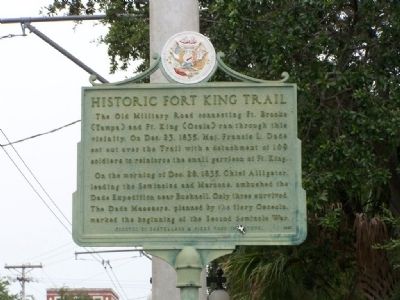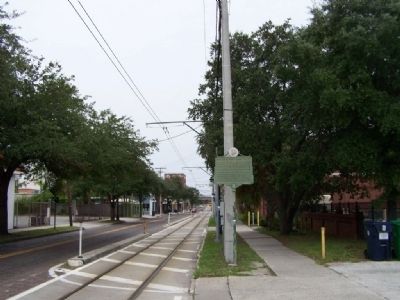Tampa in Hillsborough County, Florida — The American South (South Atlantic)
Historic Fort King Trail
On the morning of Dec. 28, 1835, Chief Alligator, leading the Seminoles and Maroons, ambushed the Dade Expedition near Bushnell. Only three survived. The Dade Massacre, planned by the fiery Osceola marked the beginning of the Second Seminole War.
Erected 1961 by Castellano & Pizzo Food Importers.
Topics. This historical marker is listed in these topic lists: Native Americans • Wars, US Indian. A significant historical month for this entry is December 1735.
Location. 27° 57.665′ N, 82° 26.374′ W. Marker is in Tampa, Florida, in Hillsborough County. Marker is on East 8th Ave near Angel Oliva Senior Street, on the right when traveling west. Located just west of the Ybor City Museum State Park. Angela Oliva Senior Street is also known as North 18th Street. Touch for map. Marker is in this post office area: Tampa FL 33605, United States of America. Touch for directions.
Other nearby markers. At least 8 other markers are within walking distance of this marker. Anthony P. Pizzo (a few steps from this marker); Anthony P. "Tony" Pizzo (within shouting distance of this marker); L’Unione Italiana (about 300 feet away, measured in a direct line); Mayor Nick C. Nuccio (about 300 feet away); Historic Fire Station No. 4 (about 300 feet away); Ybor Centennial Park (about 300 feet away); Orestes Ferrara (about 400 feet away); La Joven Francesa Bakery (about 400 feet away). Touch for a list and map of all markers in Tampa.
Related markers. Click here for a list of markers that are related to this marker. Old Fort King Trail
Also see . . .
1. From Wikipedia, Francis L. Dade. In the late afternoon of December 28, one hundred eighty Seminoles lay in wait approximately 25 miles south of Fort King. The Seminoles had terrain and the element of surprise in their favor. Major Dade, who was on horseback, was killed in the Seminoles' first volley, by all accounts, by the very first shot, which by pre arranged plan began the attack. Many of the soldiers, who were in two single file lines, were quickly killed. Few even managed to get their flintlocks out from underneath their heavy winter coats. Only three soldiers survived the massacre, and it is said that one had to crawl, due to his injuries, the 75 miles back to Fort Brooke. A
few months later, when travel in the area was again possible, the dead soldiers were buried at the site. This event started the second Seminole War, which lasted until 1842. (Submitted on July 8, 2008, by Mike Stroud of Bluffton, South Carolina.)
2. Fort King (also known as Camp King or Cantonment King). Located near the corner of East Fort King Street and 39th Avenue in Ocala, the site is a U.S. National Historic Landmark (designated as such on February 24, 2004). (Submitted on July 8, 2008, by Mike Stroud of Bluffton, South Carolina.)
Additional commentary.
1. Alligator, Today known as Lake City, Florida
In 1817, an Seminole Chief by the name of Halpatter Tustennuggee also known as Chief Alligator. The first name of Lake City was "Alpata Telophka" which means Alligator Town. He commanded the Indian village, which is now Lake City . Chief Alligator named the village "Alligator" after himself. Chief Alligator spoke English and mingled with the earlier settlers and by 1824 several white settlers came to the village of Alligator. A treaty was signed by which the Chief and village of Seminole Indians agreed to relocate further south by Ocala. This embittered Chief Alligator commanded several raids on the settlers and after several cruel confrontations, the Chief was transported to Arkansas along with the other Seminole Indians from Florida. By 1830 a census was taken showing many settlers were taking root in Alligator. As a matter of reference, original settlers are shown on the tombstones in number of old cemeteries in the area and some of the older families in the area bear reference to direct descendants of the first settlers (Submitted on July 8, 2008, by Mike Stroud of Bluffton, South Carolina.) Originally from http://www.homeslakecityflorida.com
— Submitted August 15, 2017, by J. Makali Bruton of Accra, Ghana.
Additional keywords. Seminole Wars
Credits. This page was last revised on November 27, 2018. It was originally submitted on July 8, 2008, by Mike Stroud of Bluffton, South Carolina. This page has been viewed 3,765 times since then and 82 times this year. Last updated on November 8, 2018, by Cosmos Mariner of Cape Canaveral, Florida. Photos: 1, 2. submitted on July 8, 2008, by Mike Stroud of Bluffton, South Carolina. • Bill Pfingsten was the editor who published this page.

